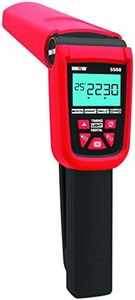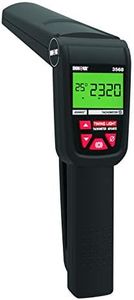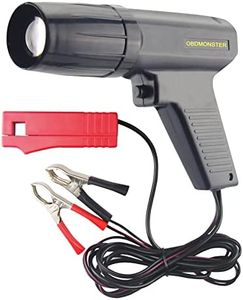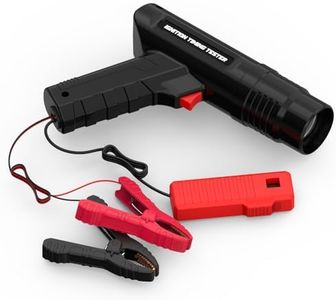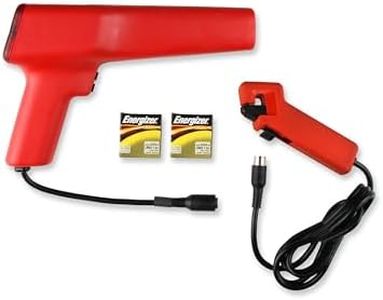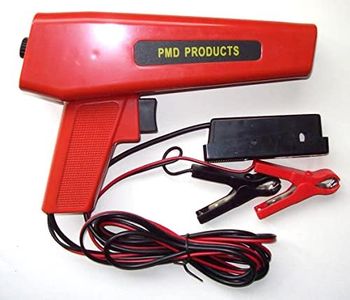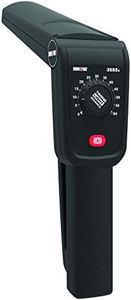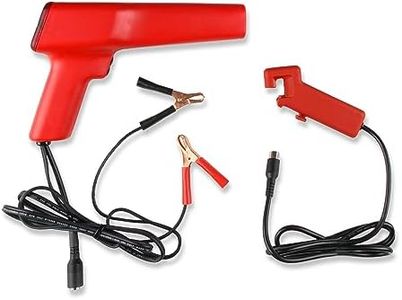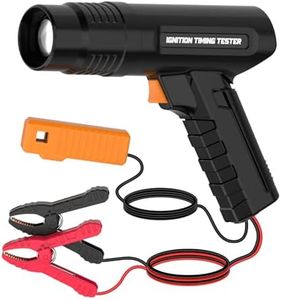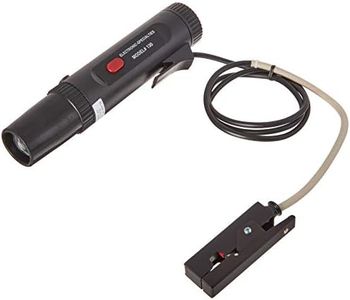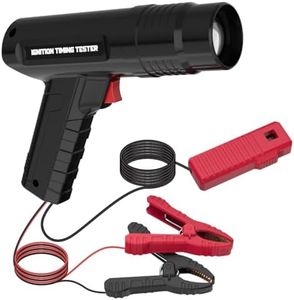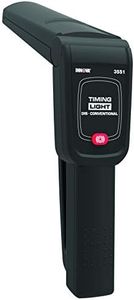10 Best Timing Lights 2025 in the United States
Our technology thoroughly searches through the online shopping world, reviewing hundreds of sites. We then process and analyze this information, updating in real-time to bring you the latest top-rated products. This way, you always get the best and most current options available.

Our Top Picks
Winner
Innova 5568 Pro Digital Timing Light with Storage Case
Most important from
2708 reviews
The Innova 5568 Pro Digital Timing Light is a solid option for those needing a reliable timing light for automotive purposes. It offers a four-function digital readout that includes tachometer, advance, dwell, and voltage, which can be especially beneficial for mechanics and DIY enthusiasts looking for a versatile tool. One of its standout features is the patented skip circuitry that allows it to test up to 9,990 RPM, accommodating a wide range of engines. The heavy-duty shockproof housing ensures durability, making it a good choice for tough work environments. Additionally, it comes with detachable 6-foot leads and is designed for one-hand operation, enhancing ease of use. The included molded plastic storage case is a nice touch for keeping everything organized and protected.
There are some aspects to consider before purchasing. While the screen size of 2.5 inches provides essential information, it may be challenging to read in bright light conditions. Being made from plastic, the unit, although durable, might not match the ruggedness of metal counterparts. Some users may find the price a bit high compared to simpler timing lights that lack advanced features. The Innova 5568 Pro is a feature-rich timing light well-suited for automotive enthusiasts who require precision and reliability, but it may not be necessary for those with basic timing needs.
Most important from
2708 reviews
KZYEE KT60 Engine Timing Light with Tachometer, Timing Light Automotive 12V for 2&4 Stroke Petrol Engine for Old Classical Cars, Motorcycles, Marine, Agricultural Machinery
Most important from
321 reviews
The KZYEE KT60 Engine Timing Light is a practical tool for tuning the ignition timing of various petrol engines, including those in classic cars, motorcycles, boats, and farm machinery. One of its main strengths is its accurate digital readout, with an RPM range that goes up to 10,000, making it suitable for a wide range of vehicles. The LED digital display provides clear and precise data, which helps in fine-tuning your engine for optimal performance. This feature is particularly valuable as it eliminates the guesswork often associated with timing adjustments.
Users have noted the importance of correctly using the sliding sensor clip to avoid inaccurate readings, so a bit of care is needed during setup. The KT60 is also highlighted for its safety features, including intuitive sensor clamps and built-in overload protection, which help prevent potential damage to your vehicle's battery and the device itself. The product is battery-powered, adding to its portability and ease of use.
However, the plastic build may not be as durable as some might prefer, especially in more rugged environments. Despite this, the KZYEE KT60 is a good choice for both car enthusiasts and professional mechanics looking for a reliable and user-friendly timing light for various petrol engines.
Most important from
321 reviews
Innova 3568 Digital Timing Light
Most important from
2245 reviews
The Innova 3568 Digital Timing Light is a solid choice for both automotive enthusiasts and professionals who require accurate timing adjustments. One of its standout features is the direct reading advance scale that adjusts from 0 to 90 degrees, making it versatile for various ignition systems, whether conventional or electronic. The digital tachometer is impressive, covering a range from 249 to 9,990 RPM, with patented skip circuitry that enhances its testing capabilities at high RPMs. This means it can cater to various engine types, which is a big plus.
The split-screen digital LCD readout is user-friendly, allowing you to view both the tachometer and advance functions at the same time, which simplifies the timing process. Additionally, the slim, rotating barrel is designed for improved aiming at the timing mark, helping you to work efficiently in tight spaces.
While the Innova 3568 is praised for its ease of use, some users might find the digital display a bit small or difficult to read in bright sunlight. Durability-wise, it's made from Acrylonitrile Butadiene Styrene (ABS), which is lightweight but may not be as rugged as some metal competitors, potentially raising concerns for those working in harsher conditions. In terms of size, its dimensions (14.5 x 10 x 3.5 inches) and weight (8 ounces) make it portable, but it may be slightly bulky for those who need something more compact.
Most important from
2245 reviews
Buying Guide for the Best Timing Lights
Choosing the right timing light can significantly improve your ability to tune and maintain your vehicle's engine. Timing lights are essential tools for checking and adjusting the ignition timing of an engine, ensuring it runs efficiently and smoothly. When selecting a timing light, it's important to consider several key specifications to ensure you get the best fit for your needs. Understanding these specs will help you make an informed decision and get the most out of your purchase.FAQ
Most Popular Categories Right Now
